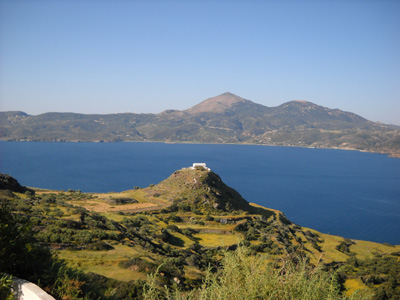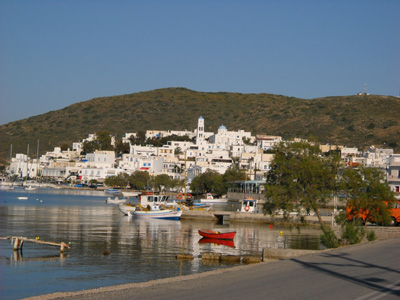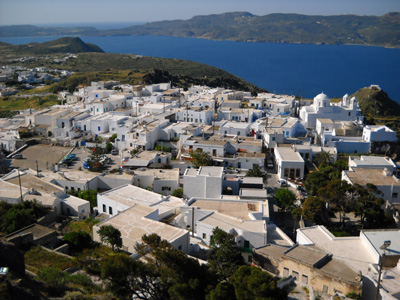Milos is situated in the western
Cyclades. It has an area of 150 km˛ with about 5000 people
living there. It makes it one of the bigger islands with the
Cyclades. Like Santorin it is volcanic which makes it very
interesting. There are hot springs, quite a few interesting
sites and some fantastic beaches.
The island became world famous through an archaeological
find. The Venus de Milos is one of the most famous artefacts
ever discovered. The statue from the first century was
excavated in 1820 and is considered one (if not the) example
of Ancient Greek statuary. It is now on display in the Louvre
in Paris.

The vast majority of tourists visiting the Cyclades ignore
Milos. In a way that is wrong but of course there are good
reasons. The most obvious one is the fact that Milos is
surprisingly difficult to reach. There is no international
airport and it is not on any of the major ferry routes that
connect the Cyclades with Athens. As a result you'll hardly
meet any package holiday makers but backpackers and
independent travellers instead.
Another although less obvious reason is the fact that the
locals do not actually depend on tourism. They really don't
care that much. The island is rich in minerals and ores. The
mines are well hidden but if you are interested in mining
give it a go anyways. Milos has rich deposits of ore,
minerals and crystals; pumice, sulphur, betonit, kaolin and
perlite for example.
There are three bigger settlements on the island: Adamas,
Plaka and Pollonia.
Adamas

The harbour town Adamas is the main settlement on the island.
Approximately 2000 people live here. Most visitors not only
arrive here but also stay in one of the local hotels. There
are plenty of rooms to rent, hotels and restaurants but also
a little mining museum (entrance is free) which is quite
interesting.
Adamas is ideal as a base if you want to discover the
islands. From here he can get pretty much everywhere by bus.
From here you can also book a day trip to Antimilos. The
island is uninhabited but quite interesting. A day trip will
cost about 16 Euro.
5 kilometres out of town is a camp site. During season their
mini van will pick you up at the port.
Plaka

Plaka is the old capital of Milos. It is only about 6
kilometres north of Adamas. It is up in the hill hills and
does well worth a visit. Most notably you will find the
typical narrow alleys. Other than that there might be little
to see but it is a chilled out and rather friendly place.
Pollonia: The town is also known as Apollonia. It is situated
at the eastern shore. Apollonia turned into a bit of a
touristy village. There are a number of cheap rooms and even
a small port for boats to Kimilos. As far as views go the
village wouldn't be my first choice. The old mines above the
town spoil it a bit; unless you like the sight of an old,
shut down mine.
If you go to Milos make sure you visit the ancient Roman town
of Tripiti. The excavation there shows an old theatre.
Kimolos: The small island just next to Milos is a popular
destination for day trippers. There are 5 boats a day from
Pollonia to Kimolos. One way cost only about 2 Euros. If you wish you
can spend the night but the rooms on the small Kimolos are
relatively expensive. You'll probably end up paying 35-40
Euro for a double.
Getting to Milos:
By plane – there is a small airport on Milos. There are
no international flights though. On average there are about
two flights a day to Athens. To make things worse there is no
way to get to the airport other than a taxi. They will charge
you at least 8 Euro to Adamas or what ever they want. The
lack of international airport makes the island attractive for
individual travellers though.
Ferry – there is a direct ferry to Piraeus that during summer
will go up to 3 times a day. More or less every day you can
go to Sifnos and Serifos, other islands are a lot more
difficult to reach though. There are a few boats every week
that go to Paros,
Sikinos,
Folegandros and
Crete. Even rarer
are ferries to Santorini or
Ios. The guys at the port are
very helpful though when it comes to finding a connecting
ferry. Just ask them and they can most likely sort you out.
Getting around Milos:
During season there are 6-8 busses a day that connect the
bigger settlements on the island. On top there are a number
of busses that go to the beaches down south. To get to the
more or less uninhabited south-west you need a scooter. They
can be rented in Adamas. Also popular are cycling and hiking.
|


